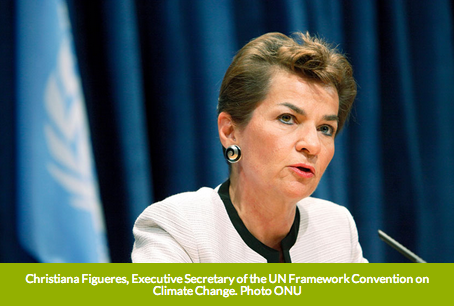12 out of 60 Climate Change Solutions proposed at Climate Summit focus on Sustainable Transport
 The GoodPlanet Foundation has compiled a set of 60 climate change solutions in a limited-edition book titled, “60 Solutions: Against Climate Change,” which is distributed to all participants of the Secretary General’s Climate Summit with the hope of inspiring decision makers to take positive actions. 12 out of 60 climate change solutions offered in the book are showcasing sustainable transport’s contribution to climate change mitigation.
The GoodPlanet Foundation has compiled a set of 60 climate change solutions in a limited-edition book titled, “60 Solutions: Against Climate Change,” which is distributed to all participants of the Secretary General’s Climate Summit with the hope of inspiring decision makers to take positive actions. 12 out of 60 climate change solutions offered in the book are showcasing sustainable transport’s contribution to climate change mitigation.
Christiana Figueres, Executive Secretary of the United Nations Framework Convention on Climate Change, notes in the book’s opening section,”Towards Global Mobility,” that governments have accepted that a low-carbon, climate-resilient future is a now a necessity, and that clean transport technology is advancing while information technology allows us to manage transport systems at lower costs with less fuel. Figueres states;
“Advances in global mobility have done much to boost social and economic development. But it has come at a cost with greenhouse gas emissions from transport rising faster than most other sectors and predictions that these will double by 2050.
 Clearly this and the associated congestion is not sustainable. To address climate change, emissions from all sources need to peak within the next ten years and decline to reach a carbon neutral global economy as early as possible in the second half of the century.
Clearly this and the associated congestion is not sustainable. To address climate change, emissions from all sources need to peak within the next ten years and decline to reach a carbon neutral global economy as early as possible in the second half of the century.
That means pushing ahead faster at all levels of government, business and civil society to ensure economies run on clean, efficient energy across all sectors. The financial, human and technology resources needed to succeed are available. The benefits – less pollution, better health and safety, energy security, lower costs – are clear.
The leaders of the transport sector can and must play a bigger role to lead the transformation, working with urban planners, engineers and technology leaders in areas such as battery storage. Mobility is also about promoting non-motorized transport from cycling to walking. Major trends are defining this and other sectors’ future. Governments have accepted that a low-carbon, climate-resilient future is a now a necessity while national and international policy is increasingly making high-carbon business a high-cost business.
Meanwhile clean transport technology is well established and advancing fast while information technology has revolutionized our ability to manage major transport systems at lower cost and with less fuel.
Mobility with ease and in comfort has always been an icon of civilization. Energy efficient and zero emission forms of transportation can take that iconic status to a whole new level. That is the ultimate goal and reward for a sector that with creativity and vision can continue to provide ever increasing levels of mobility but in a way that meets the environmental realities of the 21st century.”
The book also presents a wide range of sustainable transport best-practices and solutions including cycling, congestion charging and subway building in cities. 3 out of 11 additional solutions are;
- Use bicycles to improve finances and health: Years after introducing a plan to encourage bicycleuse, Copenhagennow has more bicycles than residents, and each person cycles on average 3 km a day, reducing90,000 tons of carbon yearly.
- Introduce a congestion charge: Congestion charging began in Stockholm in 2007, decreasing road traffic by 20%. Nearly 70% of residents now go to work by foot, bicycle or public transport, and emissions have declined 10-14% in the city core.
- Build subways to match urban growth: Since 1980, Istanbul has grown from 3 to 14 million residents. The city’s subway system now carries 1.5 million passengers daily on more than 80 km of rail track connected to a high-frequency bus network.